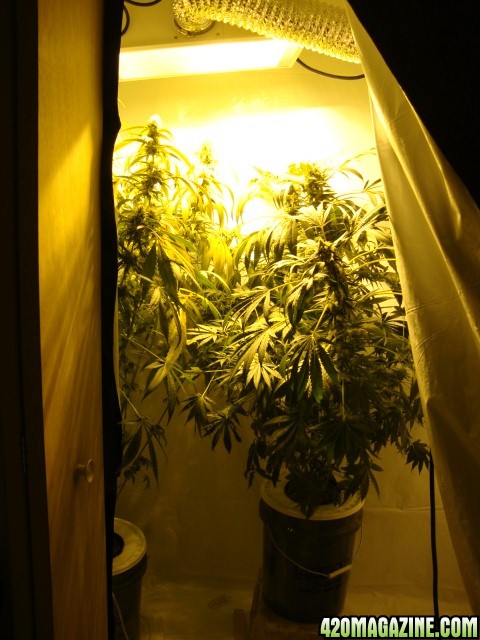If you check out the 2 plants I have left. You will wonder, How did they get so big. Now each plant, according to what i've learned on this site and others, is that each plant has a limited genetic make-up. Meaning its already programmed how big the plant could get, how many nutes it can eat up, how much sun energy it can max with. And it seems that most growers, especailly ones using the CFL's nowadays, are not even coming close to maximizing potential of the plants.
Now I guess we would have to compare nutes and TDS testers. When each plant had at least 3 nodes I felt comfortable saying that my plants were in vegetation, and gave max nutes, about 1100-1200ppm. Any higher than that I would have definately been burning the plants. They will grow at 200ppm for sure. The very minimum the plant can grow with is plain ph'd H2O. Now of course feeding your plants food will make it bigger, more bud sites, bigger buds..etc.etc.
If it were me i would at least each week up the nutes 100 -200 ppm until the plant tells you that is enough.
I would do this because I, like many others, want to maximize the potential of our plants, yields and all.
If you are limited on space, trying to keep the plants short, LSTing then I might stick around the 200ppm. And raise the ppm slower maybe to half of 1100-1200ppm.
Now I am no expert and honestly I am a noob at this, no lie. And my plants grew way bigger than I expected. I'm cool with that, but now after one grow I understand a little better what to do with my plants to keep them the size I want and still get the yield I am looking for. I have a 3.5 foot plant and a 4.5 foot plant.
To truly maximize the potential of the plants, however, you need to use the power of the sun. My light emits about 55,000 lumens, while the suns rays hit the planet at over 200,000 lumens if I remember correctly. And I dont want to get into wavelengths and distance and all that. Just trying to say, which im sure most understand, is that the best place to maximize a light source is to grow marijuana under the sun.
You'll be in flowering in no time. How long were you planning on keeping them in vegetation?
You might want to consider moving your light closer one inch or so per day. Then you could say that you are maximizing the potential of your light source.
The edges of the leaves might yellow slightly and that is one way to know that your light is too close.
Anyhow just some friendly advice, something to think about. I myself am still wrapping my head around this.
Musik \\\vVv///













